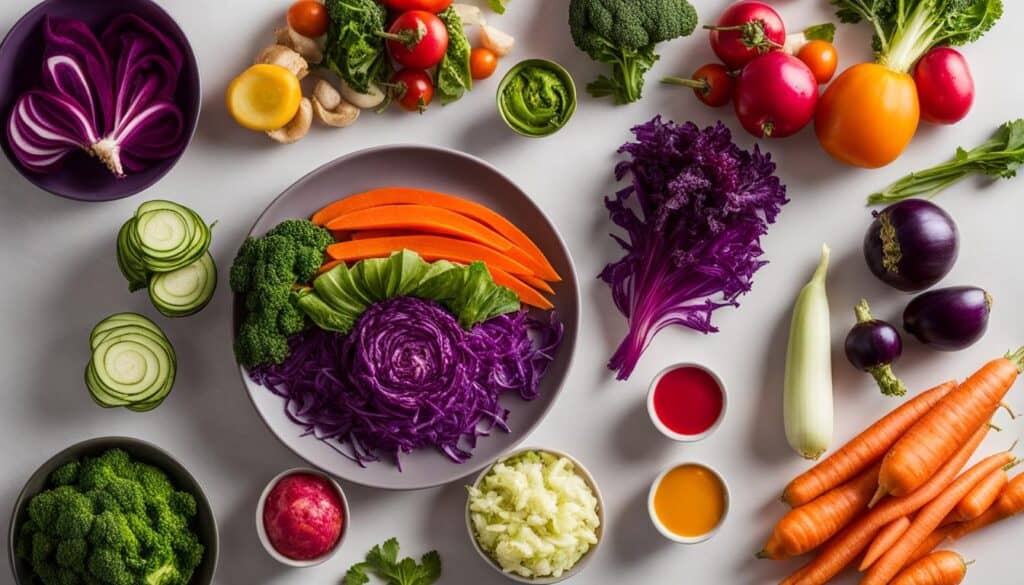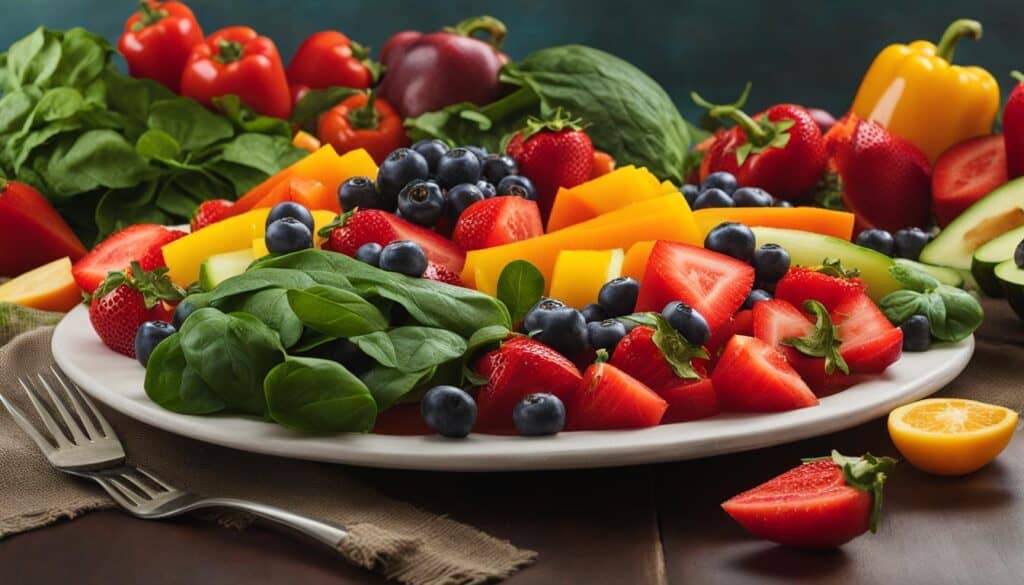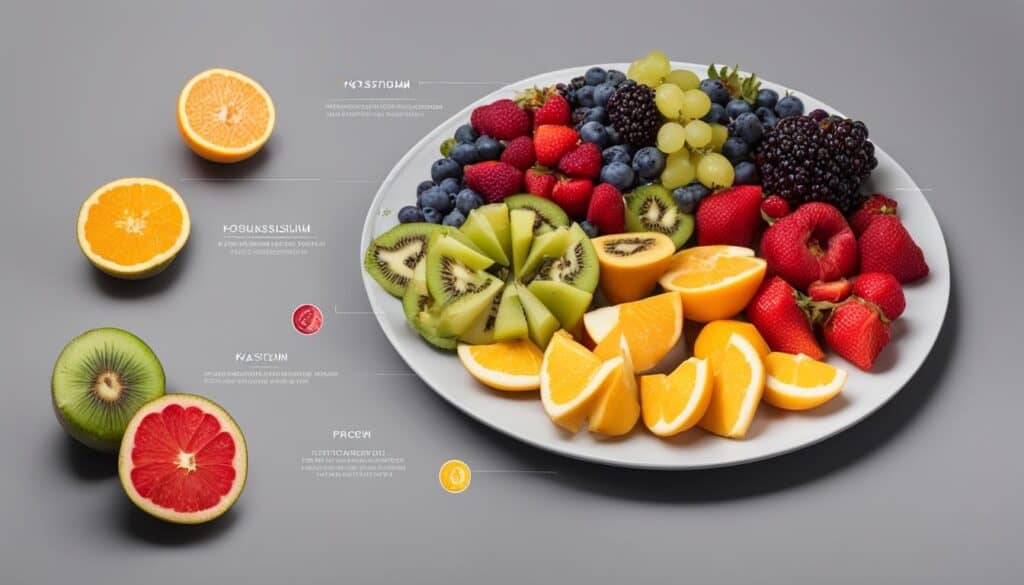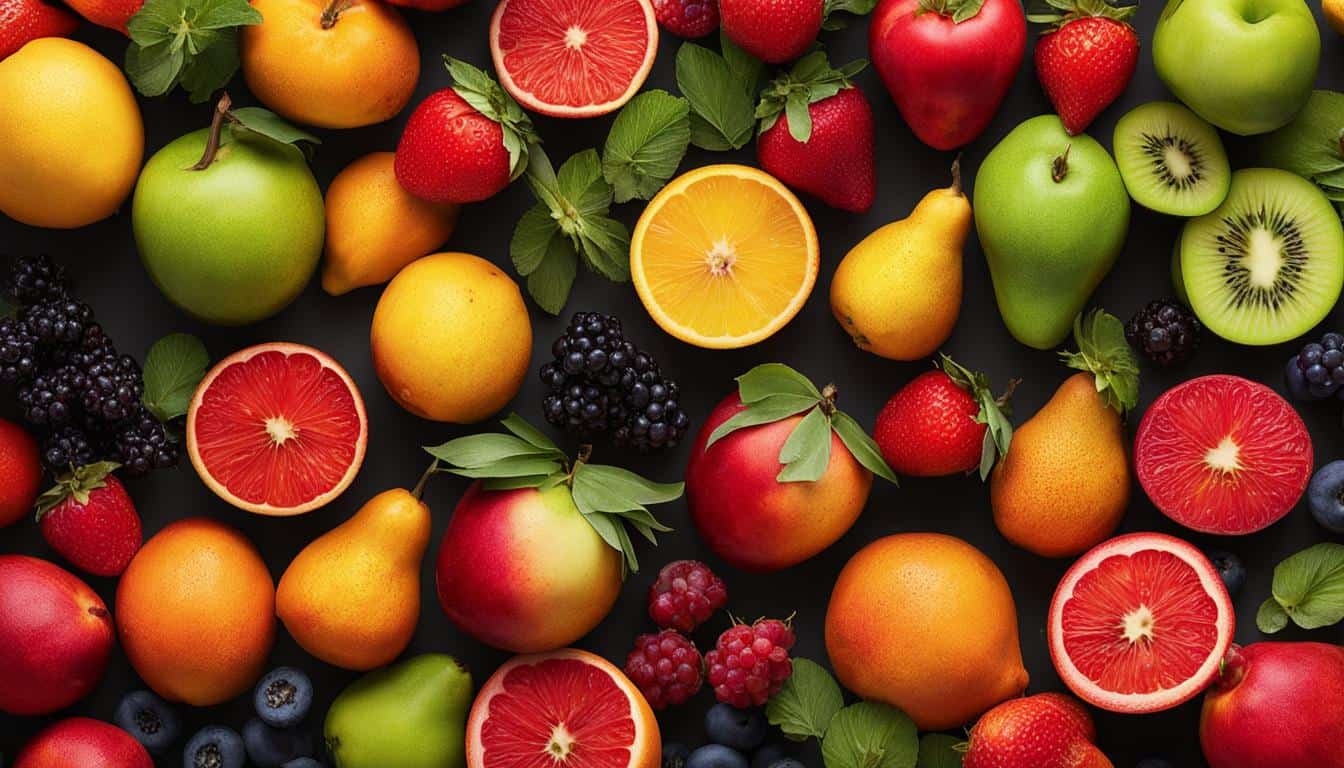Are you following a potassium-restricted diet? If so, you may be wondering what fruits you can safely enjoy. As someone with kidney disease or a related health condition, it’s important to manage your potassium intake to prevent complications. In this guide, I will walk you through a variety of fruits that are low in potassium or even potassium-free, providing you with a healthy alternative while still satisfying your taste buds.
Key Takeaways:
- Managing potassium levels is crucial for individuals with kidney disease
- A low-potassium diet can help reduce the risk of complications
- There are several fruits that are low in potassium or even potassium-free
- Consult with healthcare professionals or dietitians for personalized guidance
- Explore kidney-friendly recipes and dining options to maintain a balanced potassium intake
Before making any changes to your diet or consuming any new foods, it is strongly advised to consult with a healthcare professional or a registered dietitian for personalized guidance and safety.
Understanding Potassium and Kidney Disease
When it comes to kidney disease, understanding the role of potassium and its impact on our health is crucial. Potassium is an essential nutrient that plays a vital role in maintaining proper nerve, muscle, and heart function. However, for individuals with kidney disease, managing potassium levels is of utmost importance.
Kidneys are responsible for filtering excess potassium from our bodies. For those with compromised kidney function, this process can be challenging, leading to a build-up of potassium in the bloodstream, a condition known as hyperkalemia. Hyperkalemia can have serious health consequences, including irregular heartbeat and even heart attack.
To manage potassium levels, healthcare professionals often recommend a potassium-restricted diet. This diet involves limiting the intake of high-potassium foods while ensuring an adequate intake of other essential nutrients. Consulting with a healthcare professional or dietitian can help determine the appropriate level of potassium restriction based on individual health conditions and needs.
Managing Potassium Levels with a Low-Potassium Diet
A low-potassium diet focuses on consuming foods that are low in potassium while still providing essential nutrients. This diet typically includes a variety of fruits and vegetables that have lower potassium content, such as apples, berries, broccoli, and cauliflower. Additionally, it involves avoiding or limiting high-potassium foods like bananas, melons, and dairy products.
By adhering to a low-potassium diet, individuals with kidney disease can help manage their potassium levels and reduce the risk of complications. However, it’s essential to note that the specific dietary restrictions may vary depending on the severity of kidney disease and other individual factors. Therefore, consulting with a healthcare professional or dietitian is crucial for creating a personalized low-potassium diet plan.
| Low-Potassium Foods | High-Potassium Foods |
|---|---|
| Apples | Bananas |
| Berries | Melons |
| Broccoli | Dairy products |
| Cauliflower |
Image source: source
Low Potassium Fruits List
When following a low-potassium diet, it’s essential to identify fruits that are low in potassium or even potassium-free. These fruits can be enjoyed without worrying about their impact on potassium levels. Here is a list of some delicious low potassium fruits and their approximate potassium content:
| Fruit | Approximate Potassium Content (per 100g) |
|---|---|
| Apples | 107mg |
| Apricots | 259mg |
| Blackberries | 162mg |
| Blueberries | 77mg |
| Cherries | 222mg |
| Cranberries | 80mg |
| Grapes | 191mg |
| Grapefruit | 135mg |
| Mandarin Oranges | 166mg |
| Peaches | 190mg |
| Pears | 116mg |
| Pineapple | 109mg |
| Raspberries | 151mg |
| Strawberries | 153mg |
| Tangerines | 166mg |
These fruits provide a wide range of flavors and nutrients, making them an excellent choice for those on a low-potassium diet. Incorporating these fruits into your meals and snacks can add variety and deliciousness to your diet without significantly impacting potassium levels.
Remember, if you have specific dietary restrictions due to kidney disease or other health conditions, it’s essential to consult with a healthcare professional or dietitian to create a personalized low-potassium diet plan that suits your needs.
Exploring Low Potassium Vegetables

When following a low-potassium diet, it’s essential to incorporate a variety of vegetables that are low in potassium. These vegetables provide not only essential nutrients but also delicious flavors and textures to meals. Here are some examples of low potassium vegetables that can be enjoyed as part of a balanced diet:
| Vegetable | Potassium Content (per 100g) |
|---|---|
| Asparagus | 202mg |
| Broccoli | 293mg |
| Cabbage | 170mg |
| Carrots | 320mg |
| Cauliflower | 176mg |
| Celery | 260mg |
| Cucumber | 136mg |
| Eggplant | 229mg |
| Kale | 223mg |
| Mushrooms | 318mg |
| Onions | 146mg |
| Peas | 244mg |
| Peppers | 175mg |
| Squash | 162mg |
| Radish | 183mg |
| Water Chestnuts | 584mg |
These vegetables can be prepared and enjoyed in various ways, adding depth and nutrition to your meals. Whether roasted, steamed, stir-fried, or incorporated into soups and salads, low potassium vegetables offer versatility and health benefits for those on a potassium-restricted diet.
Remember, if you have specific dietary needs or restrictions, it’s always best to consult with a healthcare professional or dietitian who can tailor a low-potassium diet plan to your individual needs. They can provide personalized guidance and support to ensure you maintain a balanced potassium intake while enjoying a diverse range of vegetables and overall good health.
Leaching Potassium from Vegetables
When following a low-potassium diet, leaching vegetables can be an effective method to reduce potassium levels in certain vegetables. Leaching involves soaking the vegetables in warm water to extract some of the potassium before cooking. This process can help make these vegetables more suitable for individuals who need to restrict their potassium intake. Below is a table showcasing some vegetables that can be leached and the recommended leaching techniques:
| Vegetable | Leaching Technique |
|---|---|
| White Potatoes | Peel and soak in warm water for at least two hours before cooking. |
| Sweet Potatoes | Peel and soak in warm water for at least two hours before cooking. |
| Carrots | Peel and soak in warm water for at least two hours before cooking. |
| Beets | Peel, slice, and soak in warm water for at least two hours before cooking. |
| Winter Squash | Peel, chop, and soak in warm water for at least two hours before cooking. |
| Rutabagas | Peel, cut into small pieces, and soak in warm water for at least two hours before cooking. |
By following these leaching techniques, individuals on a low-potassium diet can enjoy a wider variety of vegetables while managing their potassium intake. It is important to note that soaking the vegetables may slightly affect the taste and texture; however, it allows for greater flexibility in meal planning and a broader range of flavorful options.
“Leaching vegetables can be an effective method to reduce potassium levels in certain vegetables.”
High Potassium Foods to Avoid
In order to effectively manage potassium levels, it is important to be aware of high potassium foods that should be limited or avoided in a low-potassium diet. These foods have higher potassium levels and consuming them in excess can potentially lead to complications for individuals with kidney disease or other health conditions. By understanding which foods are high in potassium, individuals can make informed choices and maintain a balanced potassium intake. Here are some examples of high potassium foods to be cautious of:
| Food | Potassium Content (per 100g) |
|---|---|
| Bananas | 358mg |
| Melons | 228-267mg |
| Oranges | 181-237mg |
| Kiwi | 147mg |
| Mango | 168mg |
| Dried fruits | 1,000mg or more |
| Avocados | 485mg |
| Tomatoes and tomato-based products | 237-439mg |
| Beans | 140-690mg |
| Milk | 150mg |
| Yogurt | 130-141mg |
| Nuts | 200-600mg |
| Seeds | 500-700mg |
| Chocolate | 92mg |
These high potassium foods should be consumed in moderation or under the guidance of a healthcare professional or dietitian, especially for individuals with kidney disease or those following a potassium-restricted diet. Understanding the potassium content in various foods can help individuals make informed decisions and maintain a well-balanced diet that supports their overall health and wellness.
“Being mindful of high potassium foods is an essential part of managing a low-potassium diet. By avoiding or limiting these foods, individuals can effectively regulate their potassium intake and reduce the risk of complications.”
Tips for Balanced Potassium Intake
To maintain a balanced potassium intake, there are several important factors to consider. By following these tips and incorporating them into your daily routine, you can effectively manage your potassium levels while still enjoying a variety of nutritious foods.
1. Serve and Portion Control
Aim to include 2-3 servings of low potassium fruits in your diet every day. Be mindful of the recommended serving sizes for other foods as well. By paying attention to portion control, you can enjoy a diverse range of fruits, vegetables, and other foods while keeping your potassium intake in check.
2. Read Food Labels
When shopping for packaged foods, take the time to read the labels and check the potassium content. This will help you make informed choices and avoid high potassium options that may not be suitable for your dietary needs.
3. Delicious Low Potassium Recipes
Exploring recipes specifically designed for low-potassium diets can provide endless possibilities for delicious and nutritious meals. There are a wide variety of options available that incorporate low potassium fruits, vegetables, and other ingredients, allowing you to enjoy flavorful dishes while maintaining a balanced potassium intake.
Remember, it is crucial to consult with healthcare professionals or dietitians to determine the appropriate level of potassium restriction and create a personalized low-potassium diet plan that meets your individual needs. By following these tips and seeking proper guidance, you can successfully manage your potassium levels and promote overall health and well-being.
Making Kidney-Friendly Meals

When following a low-potassium diet, it is essential to explore creative and flavorful meal options that are kidney-friendly. By incorporating low-potassium fruits and vegetables, individuals can create delicious and nutritious dishes that support their overall health. Here are some ideas and recipes to inspire kidney-friendly meals:
Breakfast:
- Egg white omelet with low-potassium vegetables such as spinach, mushrooms, and peppers.
- Low-potassium fruit smoothie made with pineapple, raspberries, and almond milk.
- Whole grain toast with low-potassium spreads like avocado or low-sodium peanut butter.
Lunch:
- Grilled chicken salad with mixed greens, cherry tomatoes, cucumbers, and a low-potassium dressing.
- Veggie wrap with whole wheat tortilla, hummus, and low-potassium vegetables such as shredded carrots, cucumber, and sprouts.
- Quinoa salad with black beans, corn, diced peppers, and a squeeze of lime.
Dinner:
- Baked salmon with lemon and dill, served with roasted asparagus and quinoa.
- Low-potassium stir-fry made with tofu or lean protein, broccoli, bell peppers, and snap peas.
- Vegetable curry with onions, cauliflower, zucchini, and a low-potassium spice blend.
Snacks:
- Low-potassium yogurt parfait with low-potassium fruits like strawberries and blueberries, topped with a sprinkling of low-potassium granola.
- Crispy kale chips seasoned with a low-potassium spice blend.
- Rice cakes topped with low-potassium spreads such as almond butter or low-sodium hummus.
By incorporating these kidney-friendly meal ideas and recipes into a low-potassium diet, individuals can enjoy a wide range of delicious and nutritious options. Remember to consult with a healthcare professional or dietitian to ensure the meal plan aligns with individual dietary needs and restrictions.
Dining Out on a Low-Potassium Diet
When following a low-potassium diet, dining out can present some challenges. However, with a little planning and communication, it is still possible to enjoy restaurant meals while maintaining a balanced potassium intake. Here are some tips to help you make choices that align with your dietary needs:
- Communicate your dietary restrictions: Inform the restaurant staff about your low-potassium diet and any specific restrictions you have. This will allow them to assist you in finding suitable options or making modifications to dishes to accommodate your needs.
- Choose low-potassium starches and vegetables: Opt for starches like plain rice, pasta, or bread that are lower in potassium. When it comes to vegetables, select options such as green beans, carrots, or cauliflower, which are generally lower in potassium compared to others.
- Avoid high-potassium fruits and vegetables: Stay away from fruits and vegetables that are high in potassium, such as bananas, melons, oranges, and avocado. Be cautious of dishes that may contain these ingredients, like fruit salads or guacamole.
- Watch out for potassium-rich ingredients: Pay attention to sauces, dressings, and desserts that might contain high-potassium ingredients. Ask for them on the side or inquire about low-potassium alternatives. If in doubt, it’s best to avoid them altogether.
By applying these strategies, you can maintain a low-potassium diet and still enjoy dining out. Remember, it’s essential to communicate your dietary needs and ask questions about the menu. Many restaurants are willing to accommodate special requests, so don’t hesitate to advocate for your health.
Table: Low-Potassium Restaurant Choices
| Restaurant | Low-Potassium Menu Options |
|---|---|
| Italian | Plain pasta with olive oil and vegetables |
| Mexican | Grilled chicken or shrimp fajitas with rice and beans |
| Asian | Stir-fried vegetables with tofu and steamed rice |
| American | Grilled fish or chicken breast with steamed or roasted vegetables |
Note: The table above provides examples of low-potassium menu options at various types of restaurants. However, it is always advisable to check with the restaurant directly for specific dishes that meet your dietary requirements.
Customizing Your Low-Potassium Diet

When it comes to managing your potassium intake, a personalized low-potassium diet plan is crucial. Consulting with healthcare professionals or dietitians is the first step in creating a diet that meets your specific needs and health condition. These experts can provide valuable guidance on the appropriate level of potassium restriction, ensuring that you maintain a healthy balance.
Working with healthcare professionals allows you to have a comprehensive understanding of the foods to include and avoid in your diet. They can help you identify low-potassium alternatives to your favorite fruits and vegetables, ensuring that you still get the nutrients you need while keeping your potassium levels in check.
Furthermore, healthcare professionals can provide you with resources and educational materials to assist you in your low-potassium journey. They can recommend recipes, meal plans, and even connect you with support groups or online communities where you can find additional inspiration and motivation.
Remember, a personalized low-potassium diet is not about restriction, but rather finding creative ways to enjoy a variety of delicious and nutritious foods while maintaining your health. By working closely with healthcare professionals, you can develop a plan that suits your taste preferences, lifestyle, and overall well-being.
Conclusion
In conclusion, following a low-potassium diet is an effective way to manage potassium levels for individuals with kidney disease or other health conditions. By incorporating a variety of low potassium fruits and vegetables into your meals, you can ensure a balanced potassium intake while still enjoying flavorful and nutritious dishes.
Remember to be mindful of high potassium foods and avoid them or consume them in moderation. Leaching techniques can also be used to further reduce the potassium content in certain vegetables, allowing for more variety in your diet. However, it is always important to consult with a healthcare professional or dietitian to determine the appropriate level of potassium restriction for your specific needs.
With the guidance and support of these professionals, you can create a personalized low-potassium diet plan that promotes overall health and well-being. By being proactive in managing your potassium intake and utilizing available resources, you can take control of your health and maintain a balanced potassium level that supports your kidney function and overall wellness.
FAQ
What is a low-potassium diet?
A low-potassium diet is a dietary plan that restricts the intake of potassium for individuals with kidney disease or other health conditions. It helps manage potassium levels and reduce the risk of complications.
Why do people with kidney disease need to follow a low-potassium diet?
People with kidney disease may experience high potassium levels, which can be dangerous for their health. A low-potassium diet helps manage potassium levels and reduce the risk of complications like irregular heartbeat or heart attack.
Which fruits are low in potassium?
Some fruits that are low in potassium or potassium-free include apples, apricots, blackberries, blueberries, cherries, cranberries, grapes, grapefruit, mandarin oranges, peaches, pears, pineapple, raspberries, strawberries, and tangerines.
Can I eat vegetables on a low-potassium diet?
Yes, there are several vegetables that are low in potassium and suitable for a low-potassium diet. Some examples include alfalfa sprouts, asparagus, green or wax beans, broccoli, cabbage, carrots, cauliflower, celery, cucumber, eggplant, kale, mushrooms, onions, peas, peppers, squash, radish, and water chestnuts.
What is leaching and how does it help reduce potassium in vegetables?
Leaching is a process that involves soaking certain vegetables in warm water to extract some of the potassium before cooking. Vegetables that can be leached include white and sweet potatoes, carrots, beets, winter squash, and rutabagas. By leaching, individuals can enjoy a wider variety of vegetables while managing their potassium intake.
What high-potassium foods should be limited or avoided?
High-potassium foods that should be limited or avoided include bananas, melons, oranges, kiwi, mango, dried fruits, avocados, tomatoes and tomato-based products, beans, milk, yogurt, nuts, seeds, and chocolate.
How can I maintain a balanced potassium intake on a low-potassium diet?
It’s important to consider serving sizes and portion control. Aim for 2-3 servings of low-potassium fruits each day and be mindful of serving sizes for other foods. Reading food labels can help identify the potassium content in packaged foods. Exploring low-potassium recipes and meal options can also provide delicious and nutritious choices.
Can I still enjoy flavorful meals on a low-potassium diet?
Absolutely! There are numerous kidney-friendly recipes available that are low in potassium while still being delicious and satisfying. These recipes can help individuals on a low-potassium diet find creative ways to utilize fruits and vegetables, incorporating them into flavorful dishes that promote overall health and well-being.
Can I eat out at restaurants on a low-potassium diet?
Yes, it’s possible to dine out on a low-potassium diet. It’s important to communicate your dietary needs to the restaurant staff. Many restaurants are willing to accommodate special dietary restrictions and can provide options that meet the requirements of a low-potassium diet.
How can I customize my low-potassium diet?
To customize your low-potassium diet, it is vital to consult with a healthcare professional or dietitian. They can help determine the appropriate level of potassium restriction and create a personalized low-potassium diet plan based on your specific health condition and needs.





Leave a Reply